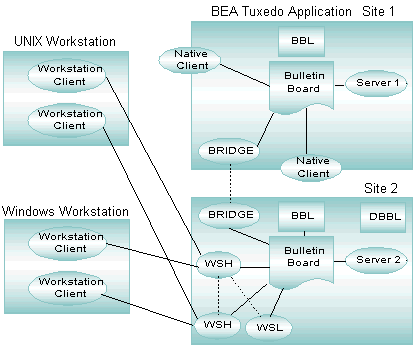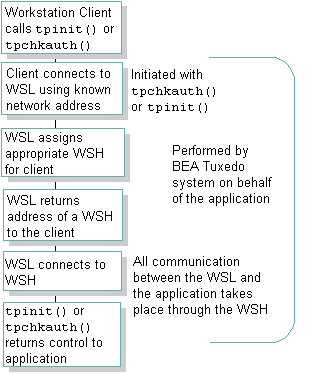Setting Up a Tuxedo Application
|
|
About Workstation Clients
This topic includes the following sections:
- What Is the Workstation Component?
- Sample Application with Four Workstation Clients
- How the Workstation Client Connects to an Application
What Is the Workstation Component?
The Workstation component of the BEA Tuxedo system allows application clients to reside on a machine that does not have a full server-side installation, that is, a machine that does not support any administration or application servers. All communication between the client and the application servers takes place over the network.
A Workstation client process can run on a Windows XP or UNIX platform. The client has access to the ATMI. The networking behind requests is transparent to the user. The Workstation client registers with the system through a Workstation handler (WSH) and has access to the same capabilities as a native client.
All communication between a Workstation client and application server is done through a Workstation handler (WSH) process.
Workstation clients can perform almost all the same functions that can be performed by network clients. They can, for example:
- Send and receive messages
- Begin, end, or commit transactions
- Send and receive unsolicited messages
- Take full advantage of any security mechanism offered to BEA Tuxedo clients
Sample Application with Four Workstation Clients
The following figure shows an example of an application with four Workstation clients.
Figure 12-1 Bank Application with Four Workstation Clients
Two workstation clients are running on a UNIX system; another two Workstation clients, on Windows. All workstation clients initially joined the application through the Workstation listener (WSL), which delegates subsequent communication to a Workstation handler. This process differs from the process that occurs when native clients join an application: in the latter case, the native clients attach directly to the bulletin board upon joining.
Administrative servers and application servers are located on SITE1 and SITE2. Any service request by a Workstation client to the application is sent over the network to the WSH. This process forwards the request to the appropriate server, gets a reply from the server, and sends the reply to the Workstation client.
Note: The term resource manager refers to an implementation of the XA standard interfaces that provides transaction capabilities and permanence of actions for a BEA Tuxedo application. The most common example of a resource manager is a database. A resource manager is accessed and controlled within a global transaction.
Because the application is distributed across two machines in this example, it is running in MP mode. The Workstation client sends a request to one Workstation handler, the Workstation handler forwards the request to a BRIDGE process, and the BRIDGE process, in turn, forwards the request to the correct machine.
How the Workstation Client Connects to an Application
The following flowchart shows how a Workstation client connects to an application.
The client connects to the WSL process using a known network address. The process for establishing this connection is initiated when the client calls tpchkauth() or tpinit(). The WSL returns the address of a WSH to the client, and then notifies the Workstation handler process of the connection request. The WSC connects to the WSH. All further communication between the WSC and the application takes place through the WSH.

